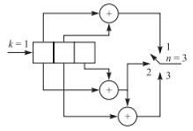Solve the following problem:
The block diagram of a (3, 1) convolutional code is shown in Figure .
1. Draw the state diagram of the code.
2. Find the transfer function T (Z) of the code.
3. Find the minimum free distance (dfree) of the code, and show the corresponding path (at distance dfree from the all-zero codeword) in the trellis.
4. Determine G(D) for this code. Use G(D) to determine whether this code is catastrophic.
5. Determine G(D) for the RSCC equivalent to this code, and sketch a block diagram of it.
6. Assume that four information bits (x1, x2, x3, x4), followed by two zero bits have been encoded and sent via a binary-symmetric channel with crossover probability equal to 0.1. The received sequence is (111, 111, 111, 111, 111, 111).
Use the Viterbi decoding algorithm to find the most likely data sequence, assuming that the convolutional code is terminated at the zero state.
